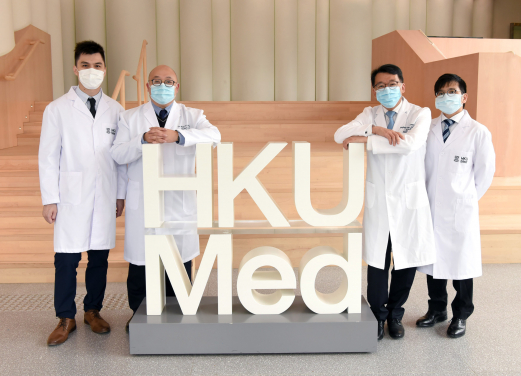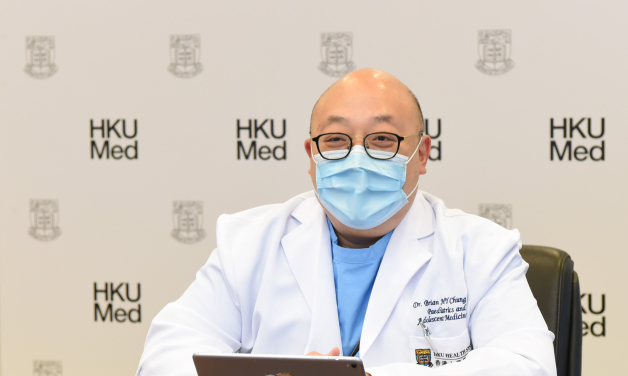Media
HKUMed discovers a novel gene in causing
the rare disease “heterotaxy syndrome”
29 Dec 2020
A research team at the Department of Paediatrics and Adolescent Medicine, LKS Faculty of Medicine, The University of Hong Kong (HKUMed) discovered a novel gene CC2D1A that is associated with human heterotaxy, a spectrum of congenital disease that disrupts the arrangement of internal organs. It is the first time that CC2D1A is reported to be associated with heterotaxy in the literature. The ground-breaking findings have been published in the leading academic journal, Circulation: Genomic and Precision Medicine. [Link to the publication]
Background
In human bodies, the left side and right side are not symmetrical. For example, heart and spleen are on the left side of the body, whereas most of the liver is on the right side. Heterotaxy, also known as situs ambiguous, is a class of human congenital disorders that are characterised by the failure to establish normal left-right asymmetry, resulting in the abnormal arrangement of internal organs on the wrong side of the body. Patients with heterotaxy have congenital birth defects that multiple organs can be affected, including the heart, lungs, liver, spleen, stomach and intestines. The estimated incidence at birth is around 1 in 10,000, and is more common in Asians than in Caucasians. Approximately 90% of heterotaxy patients have complex congenital heart defects. Patients with heterotaxy have poor prognosis, with overall survival of less than 50% in 10 years.
With the advancement of sequencing, more than 20 genes have been reported to cause heterotaxy. Some of these genes are related to the formation of cilia, which are hair-like projections that stick out from the cells surfaces. Cilia defects may cause abnormal flow of signals that guide the left-right axis formation at the embryonic development, resulting in heterotaxy. The Division of Paediatric Cardiology, Department of Paediatrics and Adolescent Medicine, HKUMed, has been taking care of this group of patients in Hong Kong for a long time. However, the genetic causes of these patients remained unknown.
Research findings
Herein, the team utilised whole exome sequencing technology to identify the disease-causing mutations in 26 patients with heterotaxy. Whole exome sequencing refers to the sequencing of all the coding regions of all genes (approximately 20,000 genes) in the human genome. The whole exome sequencing results showed that no pathogenic mutations can be identified in known genes associated with heterotaxy. Therefore, the team tried to identify new genes that have not been associated with heterotaxy. By comparing the mutations identified in patients with controls, there was a significant enrichment of CC2D1A damaging variants in patients.
The CC2D1A gene is located on chromosome 19. It produces a protein with 951 amino acids, and has been reported to be involved in regulating signalling pathway, immune response and synapse maturation. CC2D1A has been reported to be associated with intellectual disability in human1 2, but not heterotaxy. In collaboration with Dr Alvin Ma Chun-hang, Assistant Professor, Department of Health Technology and Informatics, The Hong Kong Polytechnic University, the function of this gene was further examined by the zebrafish model. Zebrafish was chosen because the zebrafish heart and human heart undergo similar morphogenetic processes.
Gene editing tool was used to edit the cc2d1a gene in the zebrafish, creating an abnormal protein that lost its functions. Zebrafish with cc2d1a mutation showed disarrangements in heart and digestive systems, suggesting that the normal left-right asymmetry was disrupted. In addition, defective ciliary was also observed, resulting in fewer and shorter cilia. More importantly, injections of wild type cc2d1a (i.e. cc2d1a without any mutation) to the edited fertilised egg can rescue the abnormal organ arrangement and ciliary defects. The result demonstrated that mutations in cc2d1a disrupt the establishment of left-right axis formation, and the disease mechanism of heterotaxy has resulted from abnormal function of cilia.
“Research for heterotaxy in Hong Kong is important as the clinical management continues to be challenging, and we are excited to understand more about the underlying cause,” said Professor Cheung Yiu-fai, Bryan Lin Professor in Paediatric Cardiology, Clinical Professor, Department of Paediatrics and Adolescent Medicine, HKUMed.
“Surprisingly, mutations in Caucasian patients with heterotaxy cannot be found in our local patients. It shows that we have to perform the genetic study at our own capacity to discover the unique disease-causing mutations in Chinese or Asians. Our study provides the first evidence on the association of the CC2D1A gene with human heterotaxy, which will facilitate the genetic diagnosis of heterotaxy patients more precisely in Hong Kong,” said Dr Brian Chung Hon-yin, Clinical Associate Professor, Department of Paediatrics and Adolescent Medicine, HKUMed.
Significance of the study
The findings of the study have significant implications in the understanding of the genetics of heterotaxy in Hong Kong. It is the first time that CC2D1A is reported to be associated with heterotaxy in the literature. With the identification of the genetic cause, preimplantation genetic diagnosis of CC2D1A in families with family history is possible.
About the research team
The research was led by Professor Cheung Yiu-fai, Bryan Lin Professor in Paediatric Cardiology, Clinical Professor; Dr Brian Chung Hon-yin, Clinical Associate Professor, Department of Paediatrics and Adolescent Medicine, HKUMed. Dr Alvin Ma Chun-hang, Assistant Professor, Department of Health Technology and Informatics, The Hong Kong Polytechnic University; and Dr Christopher Mak Chun-yu, Assistant Lecturer, Department of Paediatrics and Adolescent Medicine, HKUMed are the co-first authors.
Other researchers include Dr Yeung Kit-san, post-doctoral fellow; Dr Steven Pei Lim-cho, Senior Research Assistant; Dr Ying Dingge, Research Officer; Mr Mullin Yu Ho-chung, PhD candidate, Department of Paediatrics and Adolescent Medicine, HKUMed; Mr Kazi Md Mahmudul Hasan and Mr Chen Xiangke, PhD candidates, Department of Health Technology and Informatics, The Hong Kong Polytechnic University; Dr Chow Pak-cheong, Paediatric Consultant Cardiologist in Department of Paediatrics and Adolescent Medicine, Hong Kong Children’s Hospital and Honorary Clinical Associate Professor, Department of Paediatrics and Adolescent Medicine, HKUMed.
This work was supported in part by Seed Fund for Basic Research (No. 201711159132) of The University of Hong Kong, and the Society for the Relief of Disabled Children.
Media enquiries
Please contact LKS Faculty of Medicine of The University of Hong Kong by email
(medmedia@hku.hk).
1 Basel-Vanagaite et al. J Med Genet. Mar 2006;43(3):203-10.
2 Natiq et al. Mol Cytogenet. 2014;7:40


